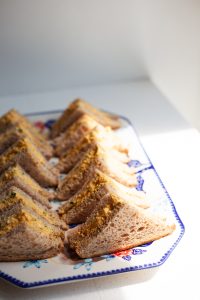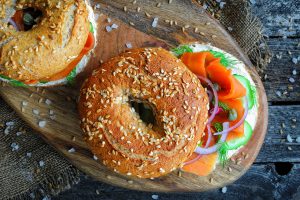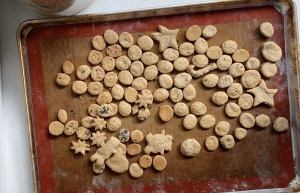Pâté Chinois is Quebec’s spin on British Shepard’s Pie, which is so popular that Le Devoir named it the unofficial national dish of Quebec in 2007.
Pâté Chinois is french for “Chinese Pie,” an unusual name for a dish that has virtually nothing to do with China. I’ll get into that later.
Pâté Chinois is a layered casserole made with ground beef, corn and mashed potatoes. I make it vegan by swapping beef for my fave “meaty mix” of lentils, walnut and TVP (textured vegetable protein). The combination of legumes, nuts and TVP make the dish rich in protein, fibre and healthy fats. I also swap for soy milk and vegan butter in the potatoes to make it fully plant-based.
Why is it named Pâté Chinois?
Pâté Chinois was a regular meal on rotation for us Montrealers. I never bothered to consider why it was called Chinese until my late twenties.
I was told a theory that many Quebecers believe to be true: Pâté Chinois was given to the Chinese railway workers which is how it got that name. In the late eighteen hundreds, over 17,000 Chinese men came to Canada to work as labourers on the construction of the western section of the transcontinental railroad.
There is just one problem with railway workers Pâté Chinois naming theory. There is no record of it. And most Chinese labourers were stationed on the west coast, miles away from Quebec.
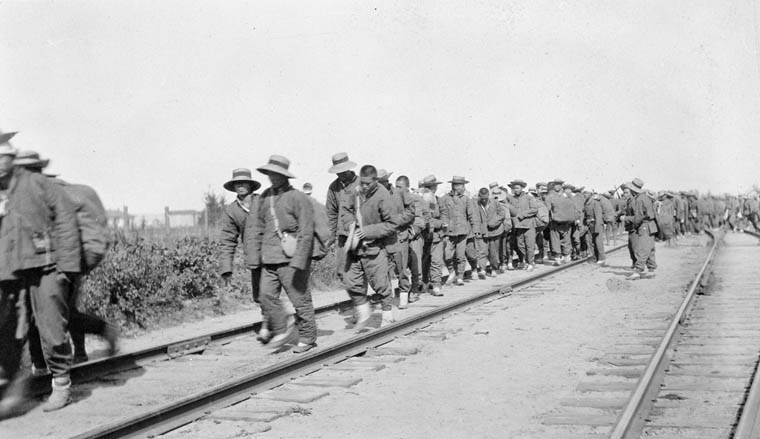
The truth is, nobody knows the origin. Even sociology professor and gastronomy expert Jean-Pierre Lemasson sought to find an answer in his book, Le Mystère insondable du pâté chinois (The Inscrutable Mystery of Pâté Chinois). He did not find a definitive answer and continues to wonder today.
But there is one theory that I find compelling. Massachusetts Journalist Amanda Beland explores a new and unknown theory for Pâté Chinois’ name origins in her podcast The Truth about Quebec’s Most Famous and Mysterious Pie.
Beland’s family came to the United States from Quebec in the ninteenth century. In the eighteen-seventies , about 10 per cent of Quebec’s population moved to the northeastern United States to escape the economic depression in Canada.
Many northeastern towns had a sizeable French-speaking population working in the textile mills. “The Quebec workers were treated poorly by the American factory owners. They were nicknamed “Chinese of the East” for their willingness to work hard for low wages at gruelling mills.” Source: CBC. An insulting and racist slur which served to denigrate both Quebecers and Chinese people.
Like Beland, my grandmother was part of these French-Canadian communities in the states. Born in Rhode Island, she eventually returned to Quebec as an adult where she met my grandfather in Montreal. She travelled back and forth between the two nations as a dual citizen. There was much cultural exchange between Franco-American and Franco-Canadian communities.
Beland’s family, on the other hand, stayed in the U.S. and gradually became more American, much like my grandmother’s nieces and nephews. However, both Beland and I share the tradition of eating Pâté Chinois.
Beland suggests that Quebecois community in the states reappropriated the title, “Chinese of the East,” providing examples in her investigation. If she’s right, then it’s not a stretch to assume they would name their beloved dish “Chinese pie.”
The name Pâté Chinois would eventually travel back to Quebec, where its popularity would live in infamy.
Of all the theories, this one resonates with me. I’m not Chinese, but I am half-Asian. My mother is a Sri Lankan immigrant who came to Montreal in 1974. Like many immigrants, my mom experienced racism and insults. Quebec nationalism could feel especially xenophobic. Much like today, politicians positioned immigrants as an imminent threat to Quebec’s language, culture and sovereignty.
Quebecers in the U.S. were themselves served the same vitriol as that Asian immigrants like my mom faced in Quebec. It’s a reminder that all people, regardless of race or religion, can be subject to oppression and discrimination on the very thin basis of difference. The struggle for dignity and equality is universal. Knowing this should be a tool to unite us.
French Quebecers have been oppressed and oppressive. For example, Bill 21 bans religious symbols in public spaces and disproportionately impacts women of colour. The goal is assimilate immigrants into the dominant culture. Not so different from how Quebecois-Americans were assimilated to mainstream American culture which is a major loss in my books. I mean how cool would it be if there were still French communities in New England were still flourishing.
Beland’s Pâté Chinois origin story also gives me comfort as a half-French Canadian, half-South Asian Canadian. I’ve felt the push and pull of two worlds apart. Never quite belonging to either. It’s a melding of my layers. Much likes the layers of Pâté Chinois.
I wondered if the name itself, Pâté Chinois is flat out racist. I consulted a Chinese-Canadian friend and she said, “Um, yeah, kinda.”
So, what do we do? Change the name? Or maybe use the name as an opportunity to think critically and engage in a conversation about race, discrimination and the common struggle of humanity.
For me, it’s chance to dream up a pluralistic world where Pâté Chinois is served up next to a heaping pot of Tadka Dhal and Ma Po tofu. That’s the world I want to live in.
Regardless of how you feel about Pâté Chinois, I hope you enjoy this vegan version.
Veganizing this dish makes it heart-healthy and better for the planet.
Be sure to listen to Amanda Beland’s podcast while you prepare the recipe.
So what are you waiting for? Make it tonight.
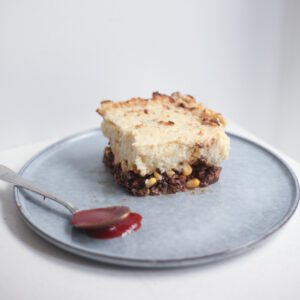
Pâté Chinois Quebec Shepherd’s Pie [Vegan & Gluten-Free]
Ingredients
Meatless filling
- 1 large onion diced
- 2 cloves garlic minced
- ½ cup brown lentils
- 1 cup textured vegetable protein
- 2 tablespoons tomato paste
- 1 tablespoon molasses
- 3 tablespoons soy sauce
- 1 teaspoon thyme
- 1/2 teaspoon rosemary
- 1 teaspoon ground sage
- 1 bay leaf
- 2 cups vegetable broth
- 1/2 cup finely chopped walnuts
- Salt and pepper to taste
Mashed potatoes
- For the Mashed Potato Topping:
- 4 cups of potatoes russet or Yukon Gold, peeled and diced
- 1/2 cup unsweetened soy milk or any plant-based milk
- ¼ tasse vegan butter or half vegan butter, half extra virgin olive oil
- Salt and pepper to taste
Other ingredients
- 2 cans corn (341 ml)
- sprinkle paprika (optional)
Instructions
- Preheat the oven to 375°F (190°C).
- For the meatless filling:
- In a large skillet, heat olive oil over medium heat. Add diced onions and garlic, and sauté until softened. Add all remaining meatless filling except for the walnuts. Bring the mixture to a simmer, lower the heat, and cover it to cook for about 15 minutes until all the broth is absorbed. It's ready when lentils are soft. If it runs too dry, add a little water. Add in the walnuts and remove from heat.
- For the Mashed Potato Topping:
- Boil the diced potatoes in a large pot of salted water until fork-tender. Drain the potatoes.
- In a bowl, mash the potatoes with soy milk, vegan butter, salt, and pepper until smooth and creamy.
- Assemble the pate chinois:
- Transfer the meatless filling to a large baking dish, spreading it evenly.
- Then, add the layer of the drained canned corn before spooning on the mashed potatoes to cover the pie completely. Sprinkle top with paprika.
- Place the baking dish in the oven and bake for 25-30 minutes or until the top is golden brown. For an extra crispy potato topping, broil the top to finish. Watch closely to avoid burning.


